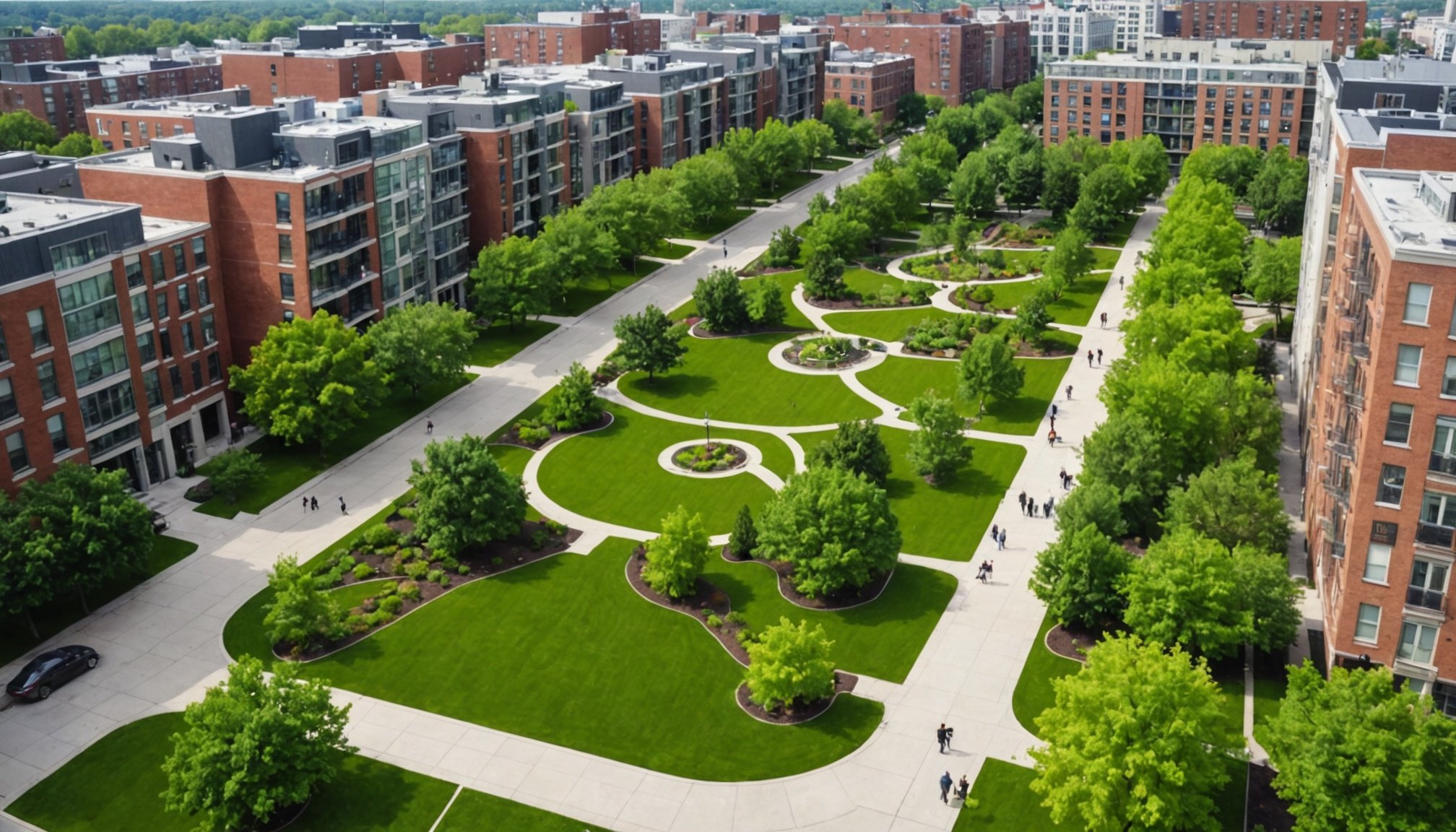Understanding Urban Green Spaces and Real Estate Value
Urban green spaces encompass a variety of areas like parks, gardens, and greenways found within city landscapes. These vital spaces serve multiple roles in fostering urban development by enhancing environmental quality and social connections. The presence of well-maintained green spaces can significantly uplift a community by providing aesthetic and recreational benefits, thus improving the overall quality of life for residents.
Importantly, urban green spaces have a profound relationship with real estate value. Properties located near these green areas often see increased valuation, as homebuyers and investors are drawn to the benefits these spaces provide. The desirability of living close to nature within a bustling urban setting often translates to higher property prices, making urban green spaces an essential factor in property investment decisions.
Have you seen this : Revolutionizing real estate: key approaches to embed sustainable urban farming practices
Urban planning plays a critical role in optimizing the advantages gained from integrating green spaces into the city’s design. Strategic planning ensures that these spaces are both accessible and beneficial to the community, thereby positively impacting property investment outcomes. As urban populations grow, the thoughtful inclusion of green spaces will continue to drive up real estate value, highlighting their significance in future urban development.
Benefits of Urban Green Spaces
Urban green spaces play a pivotal role in enhancing community well-being. These areas provide residents with opportunities for recreation, relaxation, and social interaction, fostering a sense of community and improving mental health. Studies consistently indicate that green spaces contribute to lower stress levels and higher overall life satisfaction among urban dwellers.
In the same genre : Revitalizing historic uk properties: an in-depth guide to seamlessly incorporating solar energy solutions
On the economic front, urban green spaces often lead to an increase in surrounding property values. Properties adjacent to parks, gardens, and greenways are typically more desirable, resulting in a positive ripple effect on real estate value. This increased desirability translates into higher demand and thus, higher prices for these properties. Consequently, developers are incentivised to design urban layouts that incorporate green spaces to enhance property investment opportunities.
Moreover, the environmental impact of green spaces cannot be overstated. They contribute to improved air quality, reduced heat island effects, and increased biodiversity within urban environments, aligning city development with sustainable practices. As a result, incorporating green spaces becomes not just an enhancement to urban quality of life, but a crucial component of sustainable urban planning. Embracing these benefits ensures resilience against environmental challenges and promotes long-term urban prosperity.
Statistical Analysis of Urban Green Spaces and Property Values
To truly understand the impact of urban green spaces on property valuation, a thoughtful analysis of statistical data is essential. Research studies consistently illustrate that properties adjacent to green spaces exhibit higher value appreciation compared to those without such proximity. For instance, homes near maintained parks or greenways typically experience increased valuations, often spiking by approximately 8-15% higher than their counterparts further away. This data provides quantifiable insight into the tangible benefits to real estate value.
Many studies offer a comparative analysis of neighbourhoods with and without extensive green space integration. Such analyses reveal that green spaces enhance both residential satisfaction and property investment potential. While not a universal rule, a clear trend emerges: accessible and well-maintained green areas correlate with more robust property values.
By using data-driven insights, urban planners can better justify the allocation of resources toward developing and maintaining these invaluable green assets. Emphasizing quantitative data allows stakeholders to make informed decisions about where to focus urban development efforts. Ultimately, integrating statistical perspectives enhances urban policies, aligning community aspirations with sustainable growth and emphasizing the economic advantages of urban green spaces.
Case Studies on Successful Urban Green Projects
Examining case studies offers insights into how cities effectively integrate urban green spaces into urban design. A notable example is New York City’s High Line, an elevated linear park transformed from a derelict railway. It not only revitalized surrounding neighborhoods but also triggered a real estate boom, underscoring the potent relationship between successful projects and increased real estate value.
In Singapore, the Gardens by the Bay showcase how innovative green spaces can redefine urban design. This iconic project has merged lush greenery with architectural marvels, drawing international accolades while boosting nearby property prices. These case studies underline the transformative power of green initiatives on local real estate markets.
Melbourne’s network of green roofs has been pivotal in reducing urban heat and enhancing aesthetic appeal, demonstrating the multifaceted benefits of such projects. By fostering environmental sustainability and stimulating local economies, urban green spaces have become integral to successful urban planning.
These examples emphasize that well-planned green spaces significantly enhance property investment returns, showcasing the economic potential embedded within nature-centric urban environments. Through thoughtful execution, cities can emulate these successes, driving both ecological balance and real estate growth.
Practical Implications for Real Estate Development and Urban Planning
Incorporating urban green spaces into real estate development is pivotal for enhancing property investment and community well-being. Strategies for including these spaces in new developments focus on integrating parks, green rooftops, and gardens into urban designs. Such integration not only lifts community morale but also aligns with sustainable practices, creating appealing environments for residents.
Community involvement is vital in planning green spaces that meet local needs. Engaging residents early in the planning process ensures that spaces cater to their preferences and encourage consistent use. This participatory approach fosters a stronger connection between communities and their environments.
Legal and zoning considerations shape how urban green spaces can be developed. Understanding local regulations is critical to ensure compliance and maximize the potential benefits of green spaces. Urban planners must navigate these frameworks to implement comprehensive green space initiatives effectively.
By marrying strategic planning with community input and legal insight, real estate developers can capitalize on the economic advantages that urban green spaces offer. In doing so, they contribute to creating vibrant, sustainable communities that enhance real estate values and ensure long-term urban prosperity.
Insights from Experts on Future Trends
Exploring expert opinions is crucial to anticipating future trends in urban development and green spaces. Specialists repeatedly highlight the growing importance of innovative technologies, such as smart sensors and sustainable materials, in revolutionizing urban green spaces. Future trends suggest an increased emphasis on integrating green spaces with technological advancements to enhance their efficiency and sustainability.
Urban planners predict a shift towards hybrid spaces that combine natural and digital experiences, appealing to a tech-savvy generation. Innovations like augmented reality (AR) can be used to enrich user experiences in green spaces, encouraging more interaction and appreciation. Likewise, professionals indicate a rise in vertical gardens and urban forests, aiming to counter space constraints in dense urban areas.
Insightful opinions also stress a community-centric approach, where local feedback significantly influences the development and design of future green spaces. This participatory planning ensures these areas meet community needs, promoting well-being and social connectedness. Embracing these future trends could provide substantial benefits in enhancing real estate value and fostering sustainable urban growth.



